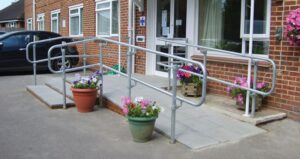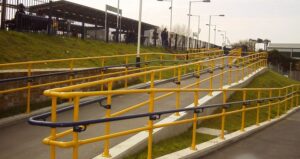Whether heading to work or out to shop, accessing healthcare or visiting a public building, all Canadians rely on safe access to the facilities that support their lives. Some might take this access for granted, but it’s a constant consideration for those with disabilities.
 “For a significant portion of our population, safe and secure access to a home, workplace, or public service isn’t always guaranteed,” says Christian King, General Manager with Kee Safety Ltd. “Anything we can do to make our facilities more accessible benefits all Canadians.”
“For a significant portion of our population, safe and secure access to a home, workplace, or public service isn’t always guaranteed,” says Christian King, General Manager with Kee Safety Ltd. “Anything we can do to make our facilities more accessible benefits all Canadians.”
Today’s facility managers and owners are aligned on the importance of accessibility. And indeed, modern facility designs and retrofits reflect an effort to create spaces that all can use. Nevertheless, there are always opportunities to improve and innovate the ways to make offices, schools, malls, and all other facilities we rely upon safer and more welcoming for everyone.
The compliance factor
It goes without saying that accessibility is more than a “nice to have.” Today, property stakeholders are compelled to make building accessibility a priority to fill their units, keep occupants and visitors safe, and comply with ever-evolving accessibility guidelines and regulations.
Surely, compliance is a big driver for building accessibility. Nationwide initiatives like the Accessible Canada Act and provincial/territorial mandates such as the Accessibility for Ontarians with Disabilities Act (AODA) spell out specific expectations concerning accessible buildings while building codes from coast to coast also hold asset owners and managers to similar standards. Moreover, the regulatory landscape is continually adapting as jurisdictions across the country share best practices and strategies between borders and move towards broader, global standards.
Kee Access Ramps: A case study in building accessibility
No doubt, moves are being made at a high level to champion accessibility in our built environment. At the same time, accessibility specialists in the private sector are also drawing on modern practices, equipment, and technology to help people with disabilities navigate with peace of mind.

Kee Safety is among those innovators. Operating out of Concord, Ontario, the company is blazing a trail for facility accessibility solutions. Its Kee Access Ramp, for example, is a modular ramping system that can be installed at existing facilities without the need for significant alterations. Moreover, the ramp is designed to comply with North American accessibility standards and features sturdy metal components and treads to shed water, snow, and ice.
“Making a facility more accessible doesn’t need to require excessive renovations or retrofits,” says King, adding, “With a modular accessibility solution like Kee Access Ramps, our aim is to make accessibility as easy, reliable, and safe as possible to attain.”
 The Kee Klamp Access ADA railing is another simple and effective solution for making buildings safer for all occupants and visitors, and keeping property stakeholders in compliance with evolving accessibility regulations. It is a smooth, sturdy, and weather-resistant handrail that can be affixed to existing infrastructure to provide a continuous helping hand for people with disabilities. And like all of Kee Safety’s products, it is also designed to comply with North American accessibility standards.
The Kee Klamp Access ADA railing is another simple and effective solution for making buildings safer for all occupants and visitors, and keeping property stakeholders in compliance with evolving accessibility regulations. It is a smooth, sturdy, and weather-resistant handrail that can be affixed to existing infrastructure to provide a continuous helping hand for people with disabilities. And like all of Kee Safety’s products, it is also designed to comply with North American accessibility standards.
Whether the goal is to build inclusive homes or safer transit, accessibility counts. And with a growing portfolio of access ramp solutions, such as its Flat Panel Ramp, Trio Ramp, Travel Ramp, and Door Wedge Ramp, Kee Safety is among the accessibility champions making Canada’s built environment more inclusive for all.
Visit Kee Safety for more information on its accessibility ramp products.





